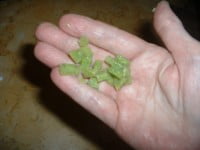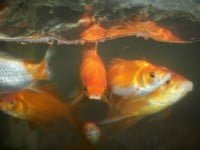Feeding Goldfish Koi is fun for the entire family
STEP 10
Feeding goldfish Koi is a little more complicated than sprinkling flakes on the water surface once or twice a day. We should be feeding our fish close to the same way and the same foods they would eat in their natural environment. In the wild, goldfish spend most of their time nibbling and grazing; eating food as they come across it. These foods consist mostly of vegetation, fish eggs and small fish. In the wild, food is scarce
Competition is fierce in the wild. Fish eggs, small fry and worms are few and far between. Vegetation makes up for the biggest part of their diet because it’s plentiful. Because of these habits, goldfish have evolved with stomachs the size of their eye. We could almost say they don’t have stomachs. The food they eat digests very quickly, leaving their system within a few short hours
Feeding goldfish
Feed less more often 4 to 6 times a day
The goldfish swim bladder organ is connected to the intestinal tract where carbon dioxide is exchanged. Co2 is a gas created from waste. This gas exchange allows fish to rise or sink at will. Improper feeding leads to an impacted or slow tract, which can trap the gas in the bladder, leading to floating issues
Feed less more often to keep the tract moving
Offer similar types of food found in their natural habitat. There is no fruit or pork; no beef or chicken, and certainly no dairy products, however, you will find an abundance of vegetation
Keep smaller fish separate from larger fish. Goldfish will eat anything they can fit in their mouths including their tank mates
Goldfish, just like humans need a varied diet because feeding a limited diet of flakes and pellets leads to an impacted tract, contributing to digestive disorders. Choose a food brand that contains less filler, such as ash. Ash consists of low grade seafood parts: scales and bone used as fillers. Feed less flakes and pellets. Flakes and pellets contain additives. Even though these food products provide the nutrition our fish need, with a little extra labor and a little added expense, our fish could be fed a healthy diet with less processed foods
Goldfish care
Feeding only once or twice a day causes gorging
Bottom dwellers by nature, this is where our fish feel safe from predators. Goldfish eyes are located in a position where it’s difficult for them to see below, and because of it, feeding at the surface may cause stress. Most new goldfish keepers make the mistake of sprinkling flakes on the surface. Surface feeding causes fish to gulp air which often leads to air bubbles in their pooh or air bubbles being released through their mouth and gills. Taking in air leads to serious issues that can easily be avoided by feeding properly
Feeding goldfish Koi
Gather the entire amount of food to be fed in hand. Hold food beneath water surface to moisten. Release in a spreading motion over a large area to keep fish from making a play for the same bite, eliminating the risk of injury. This method of feeding also discourages gorging. Make your fish work for its supper
Goldfish and humans alike share the need for the same types of nutrients and vitamins
Goldfish keepers share a common concern; how much food is not enough and how much is too much? Feed your fish small amounts throughout the day regularly. Trust your judgement
Use the standard stocking level to judge if you’re over or under feeding. Stocking level 2.5 gallons of water per 1″ of goldfish body. Exchanging 20% to 40% of fish house water weekly should keep nitrates well within the comfort zone; 20 to 40 ppm. If increased water changes are being performed to keep nitrates at safe levels, the fish are being overfed. Readings much lower than this amount indicate the fish are being underfed
High protein foods such as either shrimp or gel food are good for growing goldfish, however, they do increase the bio load, raising nitrate levels
The amount of nitrates produced in your aquarium or pond are directly related to the amount of waste being produced. Beneficial bacteria feed on the toxins goldfish waste produces. Feeding the same amount at the same times daily makes for a healthy colony. Forgetting to feed for a few days, and then trying to make up for it by overfeeding may cause a spike in the nitrogen cycle
Feeding goldfish Koi
Goldfish require very close to the same nutrients as we do, although, they can’t tolerate some of the same foods we can because of their fast moving digestive tract. Feed vegetables rich in nutrients
No salt, sugar or preservatives
How to feed goldfish
Release pre moistened pellets or flakes in a spreading motion
What goldfish eat
Keep fish from gorging by making it difficult for them to find food. This feeding method also keeps them entertained
Feed:
Frozen peas and lima beans Cook until soft, not mushy. Remove the shells before feeding
Gel food rich in nutrients
Sweet potatoes Cut into half inch squares. Cook until soft, not mushy
Blanched, fresh spinach or green leaf lettuce
Edible water plants with a high nutritional value such as algae or duck weed
Brine shrimp, fresh shrimp, tubifex, blood worms, salmon or herring
Toasted wheat germ
Fewer lakes and pellets is the key. A healthy diet should include a variety of foods
Wheat based products are not recommended for goldfish, however, toasted wheat germ is a valuable addition to their diet. In captivity their diet is compromised along with their digestive system. Wheat germ is high in nutrients, high in roughage and has a very high energy rating; meaning, it helps other foods metabolize by increasing absorption rate. This is very beneficial for the goldfish digestive system when the temperature is dropping
Feed toasted, not raw wheat germ; keep refrigerated
Algae is one of the healthiest plants in the world; often thought of as grunge, although it grows naturally in every natural, healthy body of water, as well as every cycled fish house. Instead of removing it, let the fish indulge. Algae also feeds on nitrates keeping levels low, reducing our work load; keeping our fish safe
Feeding goldfish Koi
Duckweed is a free floating, delicious and nutritious plant. Fish love eating and hiding in it
Feeding goldfish in cold temperatures
Goldfish and beneficial bacteria as well become dormant in the winter having no core body temperature. When pond fish aren’t feeding, neither are your friendly bugs
Gel Food for Goldfish
Depending on the needs of the fish, gel food is an excellent food source for goldfish and Koi offering a healthy base to which various nutrients can be added. Pure collagen, gelatin offers a number of benefits by keeping fish from getting constipated and enhancing their health

Spreading food in a sweeping motion not only keeps your fish from gorging, it also avoids a feeding frenzy. Many a fish has lost an eye by over eager tank mates

Feed goldfish less in colder temperature
Feed less to fish in outdoor ponds as temperature begins to cool. Begin reducing the amount of food at 64f. Feed more veggies and fewer flakes or pellets as the temperature lowers. Stop feeding at 54 degrees Fahrenheit
Feeding Goldfish
Peas should be fed as a part of a healthy goldfish diet, not as a whole, because they contain naturally-occurring substances called purines. Excessive intake of these substances can cause organ related health issues
Waste that floats is a sign of a poor diet low in fiber. Healthy pooh should be similar in color to the food you’re feeding. Blackish or whitish coloration indicates sickness
Back to 10 Steps to Goldfish Koi Keeping
All rights reserved
Author: Brenda Rand